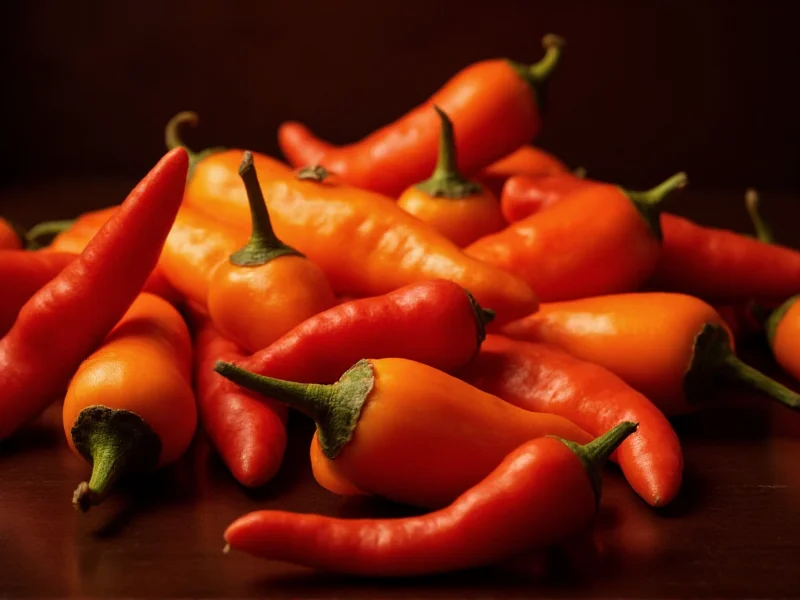Understanding where the ghost chili falls on the heat measurement spectrum provides valuable context for culinary enthusiasts, researchers, and anyone curious about extreme food experiences. The Scoville scale, developed by pharmacist Wilbur Scoville in 1912, remains the standard measurement for chili pepper heat intensity.
What Is the Scoville Scale?
The Scoville scale measures the pungency or 'heat' of chili peppers and other spicy substances. Originally, the scale relied on human taste testers who would dilute pepper extracts until the heat became undetectable. The degree of dilution determined the Scoville rating. Today, high-performance liquid chromatography (HPLC) provides more precise measurements of capsaicinoids—the compounds responsible for chili heat.
Ghost Chili Scoville Rating Explained
Official testing conducted by New Mexico State University's Chile Pepper Institute confirmed the ghost chili's heat range of 855,000 to 1,041,427 SHU. This measurement came after the ghost chili gained recognition as the world's hottest pepper in 2007, verified by Guinness World Records.
| Pepper Variety | Scoville Heat Units (SHU) | Heat Comparison |
|---|---|---|
| Ghost Chili (Bhut Jolokia) | 855,000–1,041,427 | 400× Tabasco sauce |
| Carolina Reaper | 1,400,000–2,200,000 | 2× Ghost Chili |
| Habanero | 100,000–350,000 | ⅓ Ghost Chili |
| Jalapeño | 2,500–8,000 | 1/100 Ghost Chili |
| Bell Pepper | 0 | No heat |
Historical Context of the Ghost Pepper
Native to Northeast India, the ghost chili (known locally as Bhut Jolokia, meaning 'ghost pepper') has been cultivated for centuries. Farmers traditionally used these peppers as a natural elephant deterrent due to their extreme heat. The pepper gained international attention when researchers from New Mexico State University conducted formal testing and confirmed its unprecedented heat level.
Physiological Effects of Ghost Chili Consumption
Consuming ghost chili peppers triggers significant physiological responses. The capsaicin content activates TRPV1 receptors throughout the body, causing:
- Immediate burning sensation in the mouth and throat
- Profuse sweating and facial flushing
- Increased heart rate (tachycardia)
- Tearing eyes and runny nose
- Endorphin release creating a 'chili high'
Medical professionals warn that excessive consumption can lead to stomach pain, nausea, and in rare cases, more serious complications requiring medical attention.
Safety Considerations for Handling Ghost Peppers
Proper handling techniques are essential when working with ghost chili peppers. The concentrated capsaicin can cause severe skin irritation and eye damage. Experts recommend:
- Wearing nitrile gloves (latex provides insufficient protection)
- Avoiding contact with face or eyes during preparation
- Working in well-ventilated areas to prevent inhalation of capsaicin particles
- Having dairy products like milk or yogurt nearby to neutralize accidental exposure
- Never using bare hands to adjust contact lenses after handling
Culinary Applications of Ghost Peppers
Despite their extreme heat, ghost peppers have legitimate culinary uses when handled properly. Chefs incorporate them into:
- Specialty hot sauces where minimal quantities provide maximum heat
- Meat rubs for bold flavor profiles
- Chutneys and preserves where sugar balances the heat
- Experimental dishes requiring intense heat elements
The ghost chili's flavor profile includes distinctive smoky, fruity notes beneath the intense heat, making it valuable to experienced chefs who understand how to harness its properties safely.
Ghost Chili vs. Other Superhot Peppers
While the ghost chili held the title of world's hottest pepper for several years, newer varieties have surpassed it. The Carolina Reaper currently holds the Guinness World Record with heat levels reaching 2.2 million SHU. However, the ghost chili remains significantly hotter than more common superhots like the Trinidad Scorpion (800,000–1,400,000 SHU) and7 Pot Douglah (923,889–1,853,936 SHU).
Measuring Heat: From Subjective to Scientific
The evolution of heat measurement has moved from Scoville's original subjective taste tests to precise laboratory analysis. Modern HPLC testing measures the exact concentration of capsaicinoids and converts this to Scoville Heat Units using a standardized formula. This scientific approach provides consistent, reliable measurements that eliminate the variability of human taste testing.
Understanding Heat Variability in Ghost Peppers
Several factors influence the actual heat level of individual ghost chili peppers:
- Climate conditions during growth (drier conditions increase heat)
- Soil composition and nutrient availability
- Stage of ripeness when harvested
- Specific plant genetics
- Part of the pepper (seeds and placenta contain highest concentration)
This natural variability explains why ghost chili measurements show a range rather than a single precise number.
How does the ghost chili compare to the Carolina Reaper on the Scoville scale?
The ghost chili measures 855,000–1,041,427 SHU, while the Carolina Reaper ranges from 1,400,000 to 2,200,000 SHU. This makes the Carolina Reaper approximately twice as hot as the ghost chili, though both qualify as 'superhot' peppers that require careful handling.
Can you build tolerance to ghost chili heat over time?
Yes, regular consumption of capsaicin can build temporary tolerance as nerve receptors become desensitized. However, this tolerance resets after several days without exposure. Experts caution against deliberately building tolerance to extremely hot peppers like ghost chilies due to potential gastrointestinal damage.
What's the best way to relieve ghost chili burn?
Dairy products like milk, yogurt, or ice cream provide the most effective relief because casein protein binds to capsaicin and helps wash it away. Sugar or蜂蜜 can also help neutralize the burn. Water typically spreads the capsaicin and worsens the sensation, while alcohol provides limited relief for some people.
Why do ghost peppers vary in heat level?
Environmental factors significantly impact ghost chili heat levels. Drier growing conditions, nutrient stress, and specific soil compositions can increase capsaicin production. Individual peppers on the same plant may vary in heat, with the placenta (white ribs) and seeds containing the highest concentrations of capsaicin.
Are there any health benefits to consuming ghost peppers?
Capsaicin has demonstrated potential health benefits including pain relief, improved metabolism, and anti-inflammatory properties. However, the extreme heat of ghost peppers means these benefits come with significant risks. Most health benefits can be obtained from milder peppers without the potential for adverse reactions associated with superhot varieties.











 浙公网安备
33010002000092号
浙公网安备
33010002000092号 浙B2-20120091-4
浙B2-20120091-4